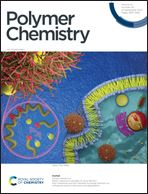A robust fully bio-based aromatic–aliphatic ketone epoxide monomer for high-performance epoxy resin containing an imine structural moiety†
Abstract
A fully bio-based aromatic–aliphatic epoxy monomer (VLE) with an α,β-unsaturated ketone structure was synthesized and cured with 4,4′-diaminodiphenylmethane (DDM) to obtain a series of robust high-performance epoxy resins containing an imine structural moiety. Vanillin and levulinic acid were employed to synthesize VLE via aldol condensation and O-glycidylation. The model reaction of VLE and aniline revealed that the epoxide and the ketone group underwent ring-opening and Schiff base reaction, respectively. The curing kinetics of VLE and DDM was investigated by non-isothermal DSC and analyzed by the Kissinger and Ozawa method. DMA, DSC, TGA, and tensile strength tests were employed to investigate the thermal and mechanical properties of the obtained epoxy resins. The formed imine structure between the ketone group and DDM resulted in a VLE-based epoxy resin with superior thermal and mechanical properties to a bisphenol A based epoxy resin. This study provides a strategy and insights for the design and synthesis of sustainable epoxide monomers for high-performance epoxy resins.



 Please wait while we load your content...
Please wait while we load your content...